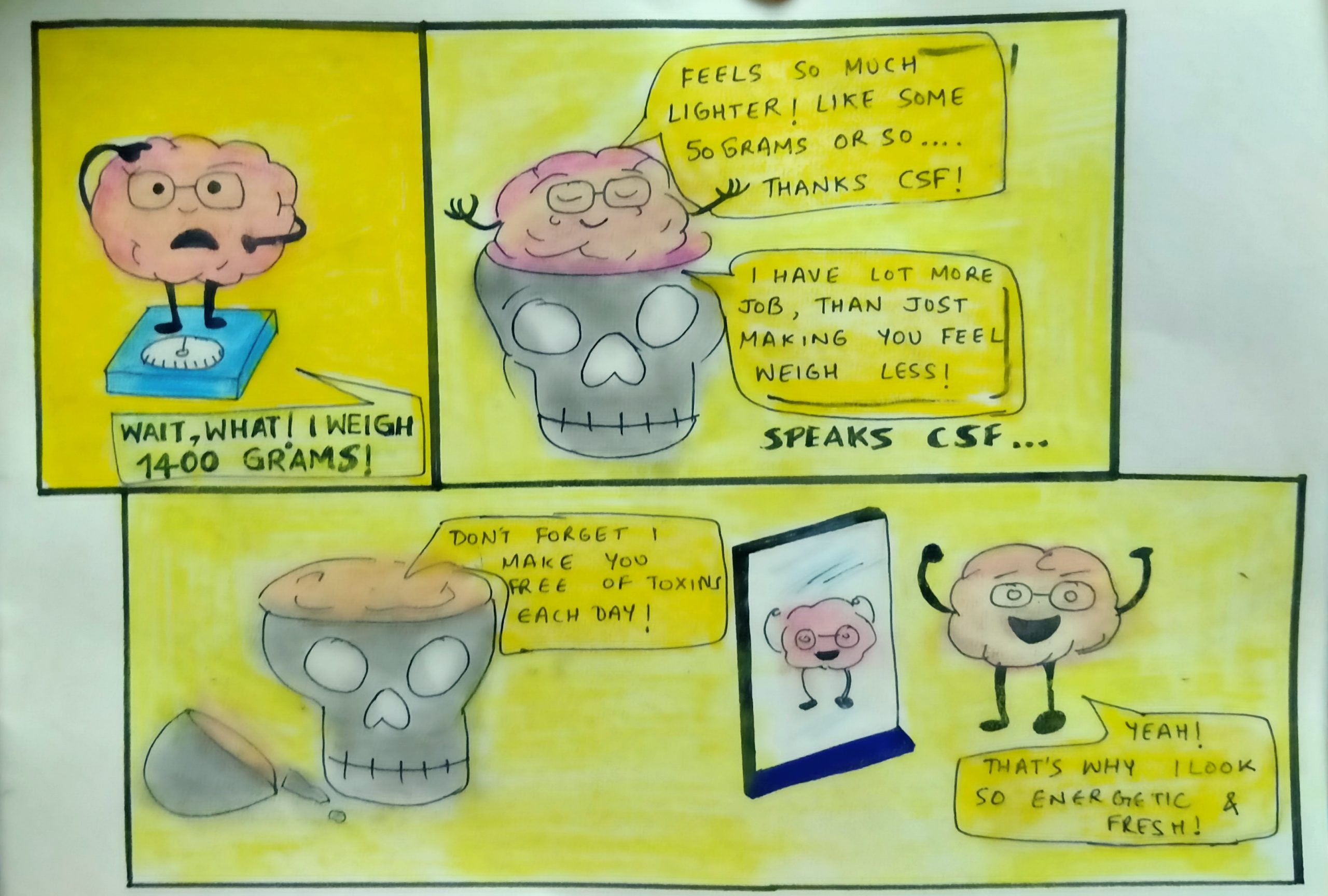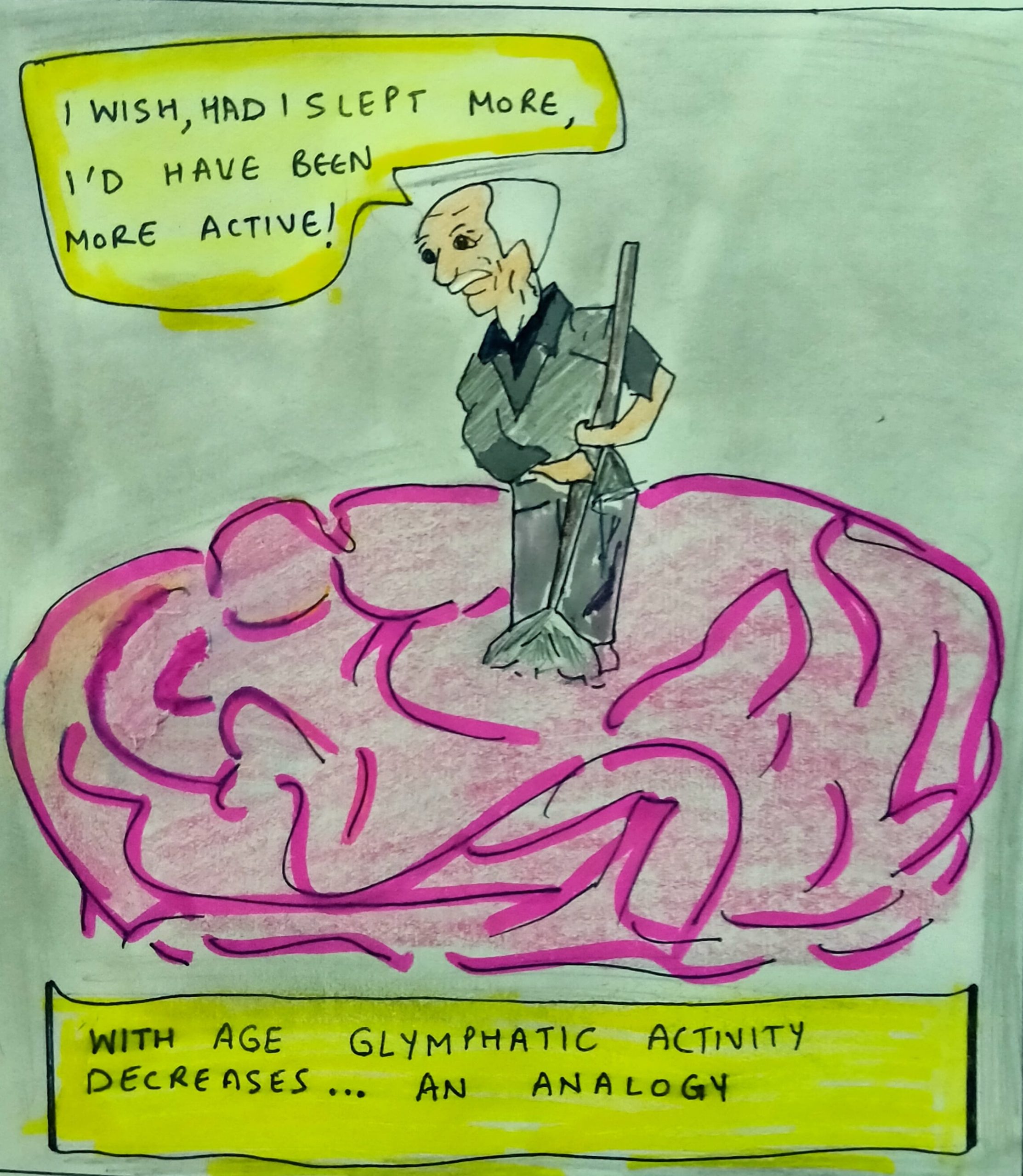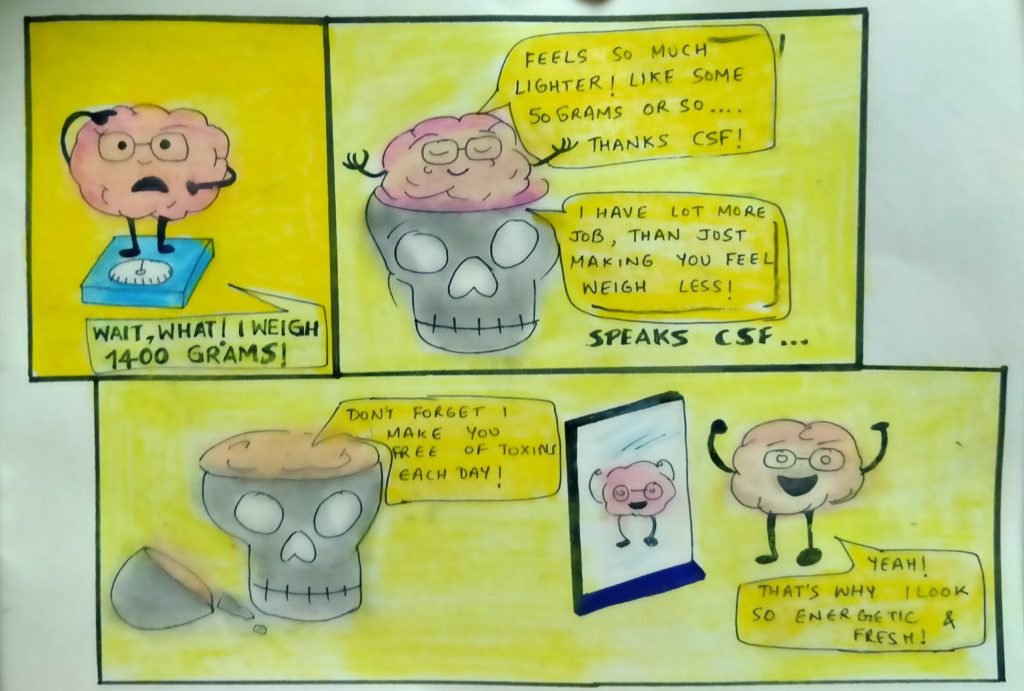Ever pulled an all-nighter, working or studying just a day before an exam? Enjoyed a party till morning? You might have come across such situations and found out that you can probably achieve that extra mile by skipping sleep. Sleep seems like a completely fine waste of time and energy. Why would living beings evolve to spend most of their lives sleeping when we could be doing something useful or exciting? If it had not been so crucial, sleep would have been eliminated during evolution. One of the reasons we probably need a good night’s sleep is for the functioning of our glymphatic system in the brain.

We all are aware of the working of the lymphatic system. Metabolism in the cells produces waste products that are potentially hazardous to the system. These are collected by the lymphatic vessels and are transported to the liver and kidney via the systemic circulation and eventually excreted out of the body.
Earlier it was thought that the central nervous system (CNS) of the brain is devoid of lymphatic vessels and that it managed its waste without any communication with the peripheral circulatory systems, but current research documented that there is a very intricately designed glymphatic system in the CNS of the brain that mimics the function of the lymphatic system to remove toxic metabolites out of the brain. Basically giving us a brain-wash every night we sleep!
We are all familiar with cerebrospinal fluid (CSF), which bathes the brain and helps reduce the bulky brain’s weight from approximately 1400 grams to around 50 grams. It also serves as a protective cushion to shield the brain from traumatic injuries. The CSF also has another role in the glymphatic system – getting rid of the waste along with it. During the slow-wave sleep phase, which is the deepest state of non-rapid eye movement (NREM) sleep, the glymphatic system is most active in clearing the toxic metabolites present in the interstitial fluid (ISF) spaces out of the brain. The waste may consist of unwanted soluble proteins and metabolic byproducts.
Anatomy of the glymphatic system
The glymphatic system uses the flow of CSF to clear the waste via a three-step process:
- At the brain’s cortical surface, cerebral arteries extending into the subarachnoid space bathed in CSF become penetrating arteries called the periarterial space (PAS) and they divide and create a perivascular space known as Virchow-Robin space. As the penetrating arteries branch into arterioles and capillaries, the CSF containing Virchow–Robin spaces narrow and finally disappear. The PAS is a coaxial system; the outer circumference of the astroglial endfeet consists of the receptors called aquaporin 4 (AQP-4), while the inner perimeter comprises the artery. The AQP-4 are water channels located at the endfeet of the Astroglia. Astroglia is a glial cell that helps in axon and synaptic support and maintenance, controlling the blood-brain barrier (BBB) and blood flow in the CNS. The name ‘glymphatic system’ is also associated with the glia-associated lymphatic system. The astroglial cells’ endfeet are structures that extend from their cell body, and the gaps present within the endfeet determine the size of molecules that can move into the interstitial fluid space.
- CSF is then driven from the PAS into the interstitial fluid (ISF) space facilitated by AQP-4. The ISF acts as a direct medium for the supply of nutrients, removal of waste and intercellular communication by covering and constantly immersing the neural cells. The transport of the CSF through the AQP-4 enables the mixing of the CSF with the ISF to remove the waste from the ISF space. This system does not function via the diffusion process; instead, the CSF flows from the PAS via the arteries’ pulsatile motion; hence, it is slower than the normal blood flow.
- Finally, the CSF carrying the waste is then transported to the large central veins’ perivenous space (PVS) by the convective flow. From here, it eventually drains into the lymphatic vessels and the systemic circulation.
Norepinephrine and the glymphatic system
Recent analysis shows that the sleep state is unique because the glymphatic activity is dramatically enhanced, while its function is suppressed during wakefulness, and the volume of ISF space was seen to be expanded more during sleep using mice as a model system. It was also revealed that norepinephrine might be a key regulator of the glymphatic system and that it may be responsible for suppressing the glymphatic activity during wakefulness by significantly decreasing the ISF volume. During sleep, there is an increase in the ISF space volume, reducing resistance towards convective flow, thus permitting CSF – ISF exchange.
Glymphatic system during aging and neurodegenerative disease

Glymphatic activity decreases during aging. The observation of an age-related decline in glymphatic activity is important because the highest risk factor identified in neurodegenerative diseases is aging. Aging may lead to loss of perivascular AQP-4 expression, which may lead to dysregulation of astroglial water transport, a decline in CSF production, reduction in arterial pulsatility due to stiffening of the arterial wall and so on. The glymphatic system has a major role in transporting out harmful proteins like the amyloid beta before it can aggregate to form plaques and cause Alzheimer’s. But if the glymphatic system dysfunctions, it may accumulate misfolded proteins and thereby render the brain more susceptible to developing various neurodegenerative diseases.
The Glymphatic system has definitely redefined the role of CSF in transport and waste clearance in the CNS. However, more research is required in the field of the glymphatic system, including targeted therapy for various neurodegenerative diseases.
REFERENCES:
- The Glymphatic system and waste clearance with brain aging: A Review
https://doi.org/10.1159/000490349
- The Glymphatic System: A Beginner’s Guide
doi: 10.1007/s11064-015-1581-6
- The Interstitial System of the Brain in Health and Disease
doi: 10.14336/AD.2020.0103. eCollection 2020 Feb.
. . .
Writer

Chitrika Salian
Illustrator

Yamini Kathuria
An amateur artist and an avid reader, currently pursuing a bachelor’s degree in Psychology at Delhi University. Intrigued by our experiences, from human consciousness to the complexity of nature, she wishes to work in an interdisciplinary area where cognitive science, psychology & neuroscience meet. Her love for connecting & sharing knowledge with others makes her feel happy & content, a reason to work for ‘The Science Paradox’ magazine.

